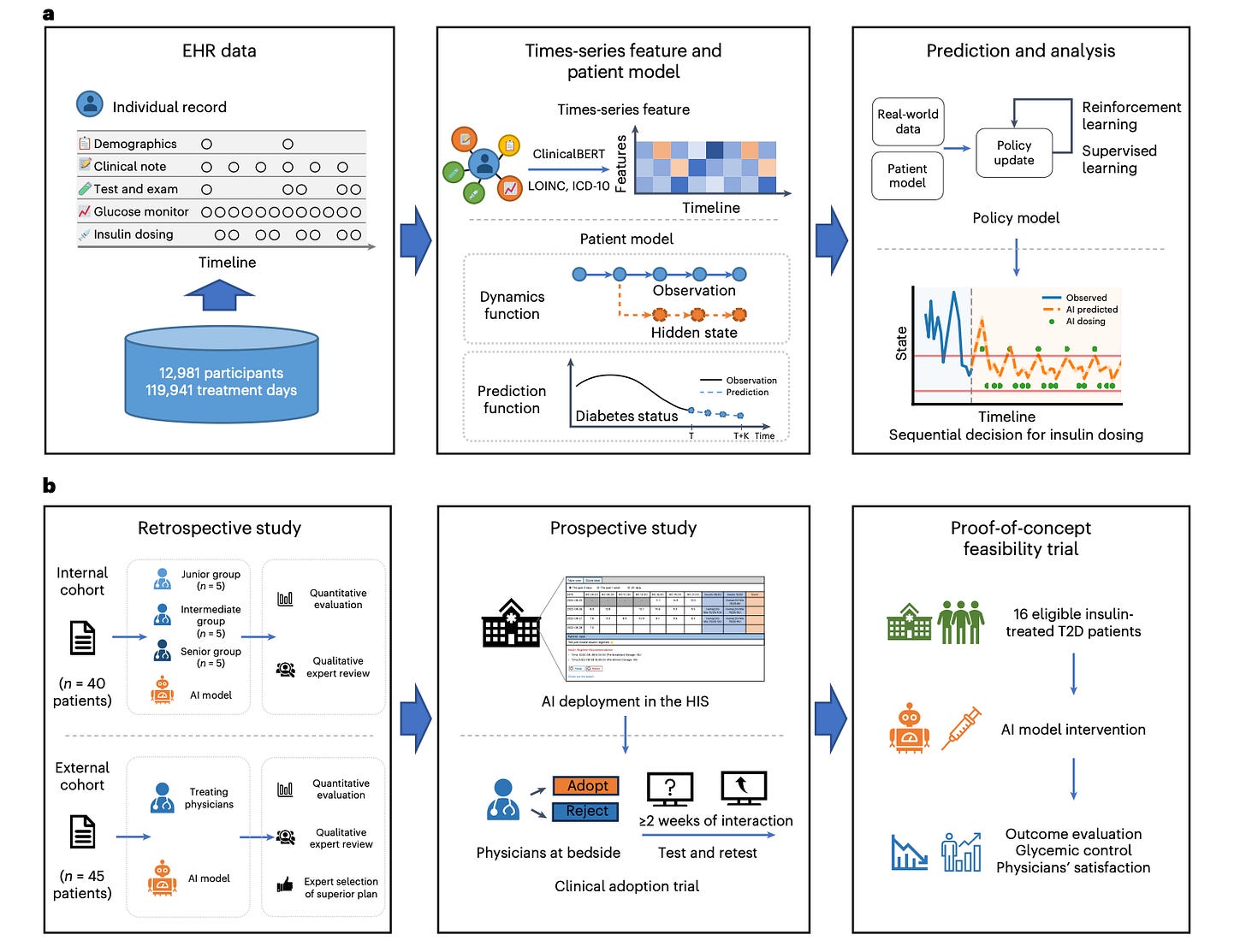Week 195
Glycemic Control, MRI Reconstruction, Ischemic Retinal Diseases, AlphaFold, Drug Discovery
We are moving our newsletter to Substack for a better experience!
In Week #195 of the Doctor Penguin newsletter, the following papers caught our attention:
1. Glycemic Control. Insulin dosage for type 2 diabetes (T2D) is typically not tailored to individual patients but titrated based on clinical guidance combined with physicians’ experience.
Wang et al. developed a reinforcement learning (RL) AI system for personalized, dynamic insulin dosing for T2D patients. The RL framework includes 1) a patient model predicting the patient's clinical status, including blood glucose value and ‘within target range’ (WTR) for glycemia control, from sequential inpatient EHR data, and 2) a policy model for multi-step planning in long-term care. The policy model learns clinician practices within safe ranges by supervised learning, as well as optimizes individualized treatment with RL. The RL-based system delivers continuous and real-time insulin dosage recommendations for patients with T2D who are receiving subcutaneous insulin injections. The AI system outperformed junior and intermediate physicians in glycemic control quantitatively in inpatients, with an increased level of satisfaction reported by the physicians using the system. Additionally, the system met the primary endpoint of a single-arm, patient-blinded, proof-of-concept feasibility trial of 16 patients, achieving a decrease in the mean daily blood glucose from 11.1 to 8.6 mmol/L without causing severe hypo/hyperglycemia.
Nature Medicine
2. MRI Reconstruction. Ultralow-field (ULF) MRI scanners (<0.1 T) can make MRI more accessible globally for their low costs. However, their much lower signal-to-noise ratio (SNR) and lengthened scan times limit clinical utility and adoption.
Man et al. developed a deep learning framework that reconstructs 3D brain MRIs in under 3 minutes at 0.055 T, compared to over 10 minutes at 1.5 and 3 T fields. Current ULF protocols require multiple acquisitions and averages to increase SNR, which lengthens scan time and increases vulnerability to motion. This new framework, however, needs only a single-number excitation (NEX) with incomplete 2D partial Fourier k-space sampling for reconstruction. When applied to healthy and elderly volunteers, the proposed acquisition and deep learning reconstruction achieved fast 3D T1W and T2W whole-brain imaging with reduced artifacts and noise and increased spatial resolution at ULF. This will enable portable, low-cost 3D ULF brain MRI for advanced image-guided therapies like transcranial magnetic stimulation, transcranial direct current stimulation, deep brain stimulation, and tumor ablation.
Science Advances
3. Ischemic Retinal Diseases. Ischemic retinal diseases (IRDs), a series of common blinding diseases, depend on accurate interpretation of fundus fluorescein angiography (FFA) images for diagnosis and treatment. However, hospitals that offer FFA may fail to produce qualified FFA reports due to a lack of experienced ophthalmologists.
Zhao et al. developed a multi-task AI system to automate FFA image phase identification, diagnose common IRDs such as diabetic retinopathy and branch retinal vein occlusion, and segment ischemic areas. They also proposed an ischemia index (CAII) based on the segmented FFA images to quantify ischemia degree, evaluate progression/treatment effectiveness by comparing CAII changes over time, and explore optimal laser therapy thresholds. Preliminarily, they found that CAII over 0.17 in BRVO and over 0.08 in diabetic retinopathy indicate patients may need laser therapy.
Cell Reports Medicine
4. AlphaFold & Drug Discovery. This year's Lasker Award honored AlphaFold, an AI model predicting protein structure from sequences.
As Russ Altman highlighted in a review of AlphaFold, this technology is already driving new drug creation. Relatedly, Mullowney et al. reviewed AI for natural product drug discovery. Natural products from bacteria, fungi, plants, and animals remain promising for novel therapeutics due to their 3D structures (as opposed to the often 'flat' synthetic structures) and their natural origins that make them likely to be transported in the body, which in turn helps drugs reach targets. Although interest in the field declined with combinatorial chemistry's rise, academic and biotech interest resurges due to the availability of large-scale omics data, where AI can accelerate natural product discovery by aiding genome/metabolome mining, structural characterization, and predicting targets and activities.
Read review
Read Mullowney et al.
-- Emma Chen, Pranav Rajpurkar & Eric Topol

